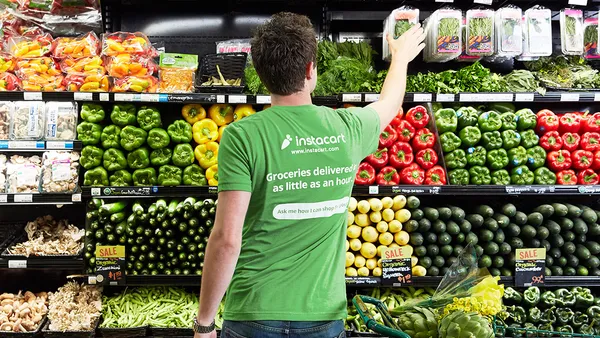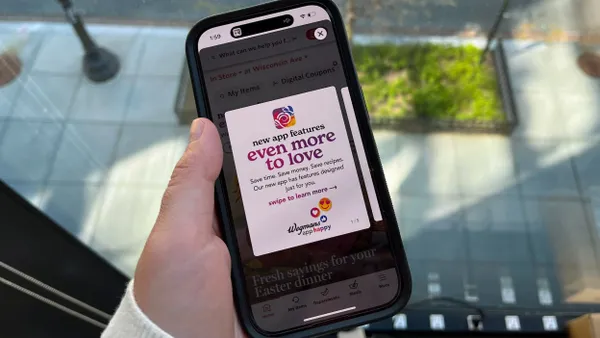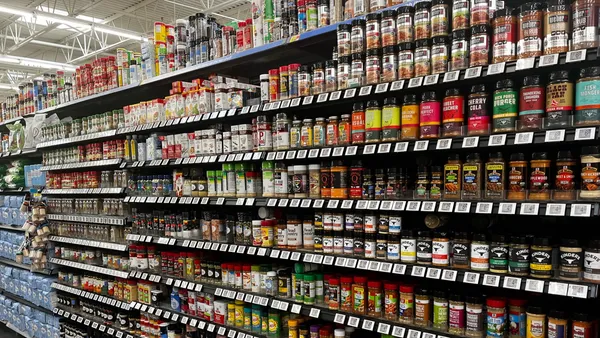By the numbers
In just a few years' time, Walmart has introduced free grocery pickup to more than 3,000 stores, including a thousand new locations this year. That’s a lightning-quick rollout, but the true impact extends well beyond the locations themselves.
Competing grocers across the country have had to respond, as they so often do, to Walmart's offensive by building out their own store pickup networks. In this way, Walmart is keeping other chains off-balance while simultaneously accelerating online grocery availability nationwide.
"Competing stores are definitely feeling the pressure to crank up click-and-collect, especially if they don't have it and aren’t differentiated on the products they offer," Scott DeGraeve, a former Peapod executive who's now chief operating officer with e-commerce firm Locai Solutions, told Grocery Dive.
Even after improvements in their click-and-collect offerings, grocers still struggle to match the price proposition and tech innovation that Walmart's scale enables.
"Where our competitors offer it, we offer it just better," Tom Ward, Walmart's senior vice president of digital operations, told Grocery Dive. "We aren't marking the prices up, we aren't charging fees, it's fully transparent and it's in more locations than ever before.”
Keeping online grocery prices low is an expensive gambit for Walmart, which is projected to lose $1 billion this year across its e-commerce division. But it's setting the foundation for an omnichannel future, Ward said. Customer data from pickup is helping Walmart adjust its rollout of delivery, now available at more than 1,000 stores, while employees who fill pickup orders also fill delivery orders once a store offers both services.
Grocery pickup is also bringing valuable new customers into Walmart's ecosystem. According to data from Numerator, customers using the service spend $124.86 on average, compared to $49.70 for in-store purchases.
"A majority of Walmart's Online Grocery Pickup users are not just users, but advocates, which projects positively for Walmart in the long-term," the firm wrote in a note in May.
As grocery pickup barrels toward a projected $35 billion in sales by next year, according to Cowen, grocers are rolling out enhancements like pickup lockers and enhanced cold-storage units. Smaller chains play up the personal touch their in-store shoppers can provide.
"Where our competitors offer it, we offer it just better. We aren't marking the prices up, we aren't charging fees, it's fully transparent and it's in more locations than ever before."

Tom Ward
Senior vice president of digital operations, Walmart
Walmart, meanwhile, aims to continue one-upping the competition. Ward said when given the choice of lower prices or a personal relationship with an order picker, consumers will almost always choose lower prices over high-touch service. Walmart utilizes a picking system that assigns multiple orders to its fulfillment workers.
"They have no idea if that product’s destined for a curbside pickup or delivery," Ward said. "Neither do the people that stage those order. In fact, it's only at the point of dispense that we determine between a pickup customer and delivery driver."
Walmart is also leveraging its vast quantities of customer data. There's a "smart substitution" tool built into its order picking software that selects alternatives to out-of-stock products based on artificial intelligence and a customer's order history. When customers go to select their pickup time, they can see which slots are the least busy, which usually translates into less time spent waiting.
Not that Walmart likes to keep customers waiting. The company recently introduced a tool that pushes a check-in alert to customers' phones once they pull into the store parking lot. Shoppers identify their car and parking space so employees can bring their order directly to them.
"It's a level of detail that you really need scale and data to be able to do really well," Ward said. "That is really hard to do if you're a smaller player."
There's more that's new and on the horizon, Ward added, including a function that lets shoppers add to their orders up to an hour after they've placed them, and promotions that recommend general merchandise, including seasonal offerings like back-to-school supplies.
Add to that the retailer's growing delivery services, including an "unlimited" delivery plan for $98 a year or $12.95 a month, and it's clear the company aims to be a dominant force in online grocery.
Walmart will continue adding grocery pickup to more stores. Now that it has crossed the halfway mark and the stores best suited for pickup have been brought online, selecting additional locations has become more of a challenge, said Ward. But the company has, naturally, developed a technology-based system for identifying the best stores for pickup as well as delivery.
"The limiting factor for us is scarcely ever ourselves," said Ward. "It's how fast can suppliers keep up with us?"




 Read more
Read more








